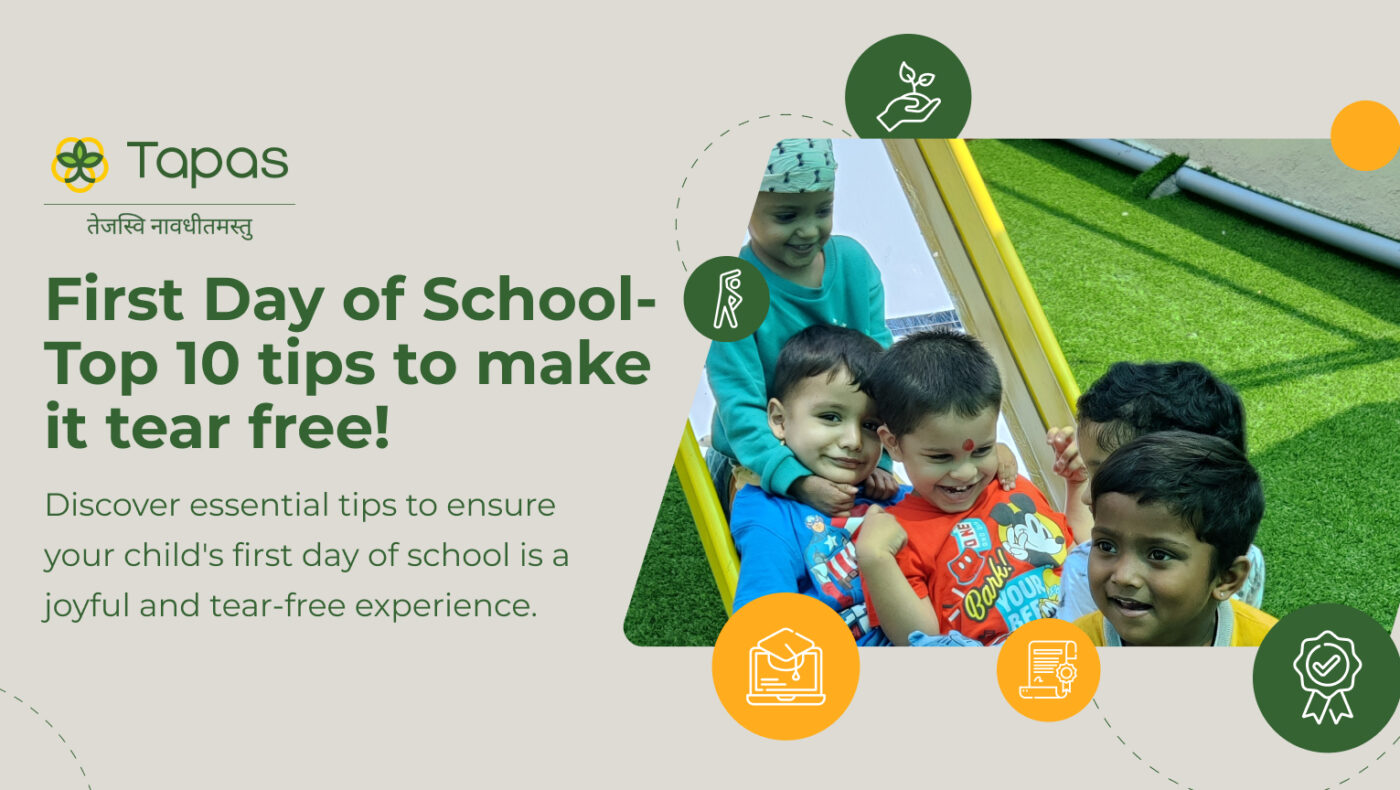The first day of school is fast approaching. For some parents, the children are returning to school after the summer break. For others, it is probably a first time experience. From my years of experiencing the first day blues, both for the preschool educator and for the preschooler, I’ve learnt some tremendous lessons on how to make this a day to look forward to instead of fearing it. Here are the top 10 tricks to ensure the same:
1. Routine – Children like routines. The first day of school can be unsettling as the child’s routine will be broken for something new and potentially ‘scary’. We often see that on the first few days of school, the mornings are rushed as the parents are pressed for time, balancing between a child who is refusing to get ready to school and being on time. It’s important that you start setting the routine for the child from a month before the school’s start date. This way the child’s biological clock is set and the first day is not a disruption of it. Early to bed is a must. Ensure that on the first day, your child is well rested. A tip to keep in mind is that a child takes about 20 minutes for every activity, especially in the morning. So plan in advance. 20 minutes to brush and bathe, 20 minutes to do the big job, 20 minutes for getting dressed, 20 minutes to eat breakfast, and so on. If you have enough 20 minutes planned, you will have a stressfree day and your child will have a stress free FIRST day!
2. Get the Teacher and School Involved – Stranger Anxiety is the most important factor in increasing the stress on the first day. Familiarise yourself and your child to the school. If possible, introduce your child to the teacher. Weave the mention of the teacher into conversations even before beginning school. ‘You’ve finished your snack Yash, I’m sure your teacher Savitha will be happy’, ‘I wonder what wonderful toys your teacher Savitha has arranged for you at school’, are some examples. Make short visits to school before the session begins to familiarise your child to the environment as this will also remove anxiety. Tour the school with your child, showing where he / she is expected to sit, play, explore and even the toilets. Explore if the teacher is open to having conversations at various times during the time leading up to the the school opening. At our school, we have always had an open hose before the start of the session where parents and children meet the teachers. During this, parents discuss about the child’s pet peeves, likes and dislikes. Since we get children from varied linguistic backgrounds, parents are asked to share a few of the important words in the child’s mother tongue for thirsty, hungry, the big and small job.
3. Read Books – A great way to introduce about school is to read books about it. Books about saying goodbye reduce the fear of the actual talk about goodbyes. Some children cannot bear to say goodbye and may be very reluctant to even listen about saying goodbyes. Through the story, they are able to project their fears and understand from a non threatening perspective. Here are some of the books that can help:
-
-
- The Kissing Hand by Audrey Penn
- David Goes to School by David Shannon
- Will I Have a Friend? by Miriam Cohen
- First Day of School by Anne Rockwell
- When I Miss You by Cornelia Maude Spelman
- Take a Kiss to School by Angela McAllister
- It’s Time for Preschool by Esme Raj Codell
- A Pocketful of Kisses by Audrey Penn- See more at:
-
4. Novelty Factor – There’s nothing like retail therapy, even for children! Invest time and maybe even a few rupees into buying a new backpack / water bottle / snack box. Anything that the child can look forward to going to school. Spending the time together to choose an object can help the child overcome fears. At our school, we build up the excitement with a complimentary kit for the child that will contain a bag, the diary (we call it a passport), the smart card (used as a security measure for child pick up), a CD (with phonics rhymes), a book of rhymes and more. This is a sure shot way to help build a bond between the child and the school.
Does your child have a favorite soft toy, pillow, blankie, car or book? Talk to the school about letting your child carry the comfort object to school. This object helps the transition from home to school. The teacher can help by creating a special place for the comfort object. It also becomes a conversation starter between the teacher and the child.
5. Don’t Sneak Away, Don’t lie – Many parents would like to ignore the painful separation. During drop off, the parents believe that sneaking away helps. This is farthest from the truth. Sneaking away makes the child insecure. Once object permanence sets in at the age of about 8 months, children understand that if the parent is not here, they must be somewhere. If so, why is mommy not with me? When you sneak away, the child is even more scared and the settling process will take longer. Another thing we have observed is the lying. Parents constantly assure the children that they are right outside. But when the child does not see the parent a few minutes later at the promised spot, the child is even more scared. Parents lie that they are going to the market, office, etc. The question is why are you not taking me, the apple of your eye, to where ever you are going? Once the child realises that he has been lied to, he does not want to have anything to do with the shool that has caused it. Very importantly, trust is broken. Lying in general to the child is an epidemic. Let us take a vow to never lie to our children.
6. Keep Goodbyes Short – Every year, we see drama unfolding at our school’s gate. Picture this: We can almost hear sad music in the background. The mother is unwilling to let the child go. There are many hugs and kisses. Many instructions hurled at the child. As the teacher takes the child in, the mother will hold onto the child till the very last moment possible stretching out her hand till only their fingers meet. Phew! This long drawn out goodbye affects the child. The child believes that the separation is making the mother really sad and the child believes that it’s the new place that is causing this and as a result does not want to stay there. In fact we encourage fathers to drop the children. We’ve seen that when the father drops the child, they just hand the child over to the teacher with a crisp bye and a pat on the back. This shows the child that the father is confident about this place, about the child taking care of himself.
7. Resist Peeping – On the first day of school, if the class has a window, there’s a parent peeping through it. I can gaurantee you this! I believe it is to do with this whole ‘helicopter parenting’ generation that has gotten out of hand. Granted, every parent is curious to know if the child has settled, how he is doing, is she getting what she wants, and so on. Peeping through a window or every time the door opens even a crack, undermines the teacher. A child sees this as a indication of the teacher not being capable enough. We are sending mixed signals to the child. On the one hand, we want the child to trust the teacher and follow her into the classroom. On the other, a peeping mom indicates a lack of trust. Further, it means that you do not believe in your child being able to manage on his own. Let us fall back and allow our children to breathe. Let us allow them to learn by trial and error. Stop the peeping!
8. Communicate – Great, the first day is over! Now is the time to talk to your child. Show that you understand the pain they may have gone through but you are also confident of how they will love the school. Ask them which part they liked, what they want different, which was their favorite toy, etc. This conversation reiterates positivity about the school and the teacher.
9. Never Compare – ‘Rohan has stopped crying, why don’t you?’ asking this to a child is like your boss asking you ‘Your colleague has achieved his targets, why can’t you?’ Nobody likes to be compared. Especially children. At an age, when we are teaching children to be social, learn to share, comparing them will only breed competition. Competition in all forms is bad for children under the age of 6. At this age they need nurturing relationships that value them for who they are and not who they are in comparison to their neighbour. This is the age when we are teaching children to collaborate, which cannot exist if there is competition. Without collaboration, the social ettiquettes that we are trying to teach children, will collapse. Each child is unique, and needs uniqe parenting too.
10 – Never use school as a threat – ‘If you don’t finish your food, I’ll complain to your teacher’, ‘If you don’t listen to me, I’ll send you to school’ These kind of statements are often used in households for creating fear in the children, which in turn is supposed to be disciplining. Last night, you threatened the child with ‘SCHOOL’ and in the morning today, you want the child to go happily to this scary place. (The same applies to doctors, needles and medicine) Use ‘school’ and ‘teacher’ in the most positive context you can. We are not monsters, we do not hurt children. In fact, you are free to come and look at our ‘Zero tolerance policy’ which states that we do not tolerate any abuse, punishment, raising of voice, threats, etc and are at liberty to fire the person found doing so.
The first few days of school can be pleasant and memorable for all stakeholders, the parent, the teacher and especially the child. Let’s work together and make it special!
Happy Parenting!

